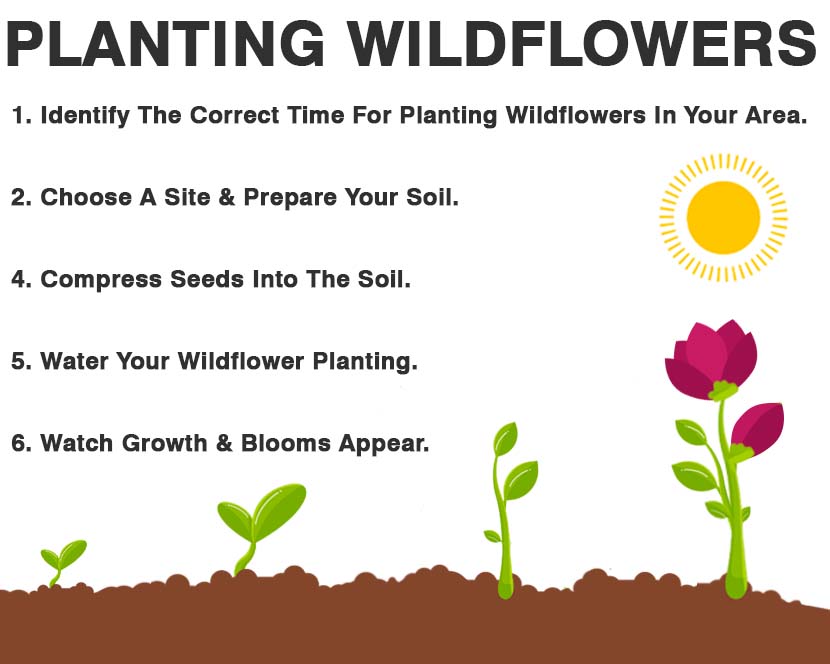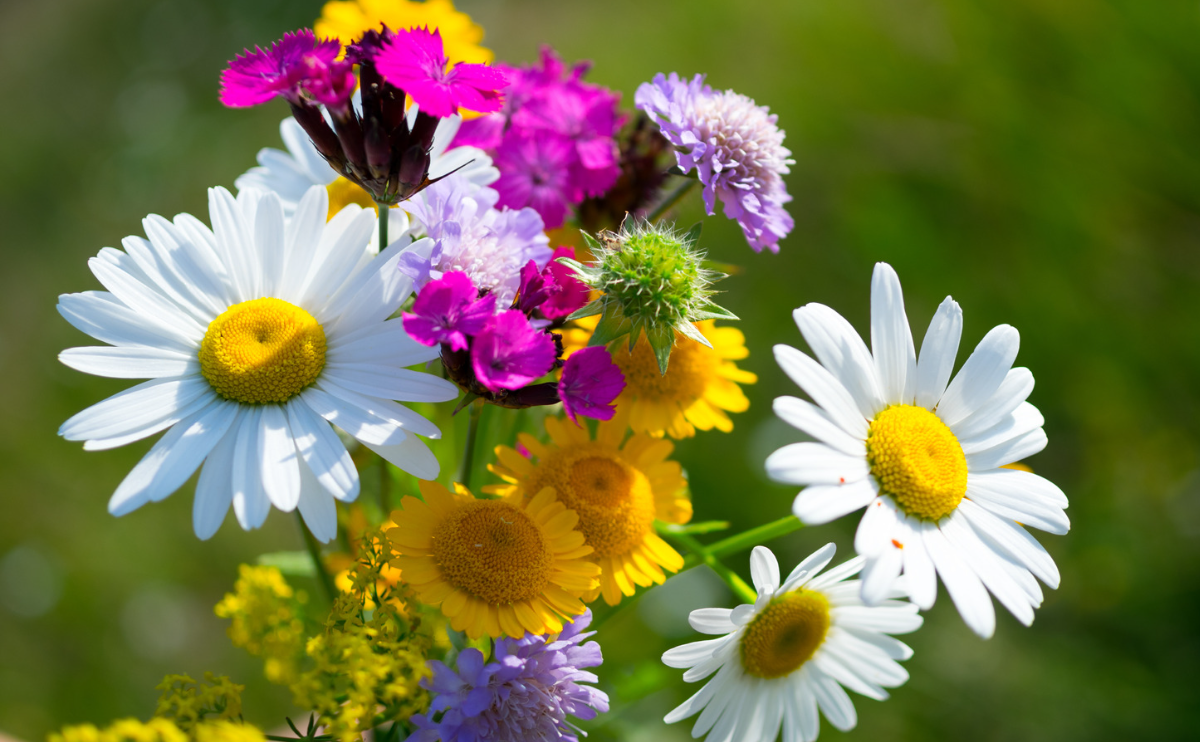A wildflower (or wild flower) is a flower that grows in the wild, meaning it was not intentionally seeded or planted. The term implies that the plant probably is neither a hybrid nor a selected cultivar that is in any way different from the way it appears in the wild as a native plant, even if it is growing where it would not naturally. The term can refer to the flowering plant as a whole, even when not in bloom, and not just the flower.
“Wildflower” is not an exact term. More precise terms include native species (naturally occurring in the area, see flora), exotic or, better, introduced species (not naturally occurring in the area), of which some are labelled invasive species (that out-compete other plants – whether native or not), imported (introduced to an area whether deliberately or accidentally) and naturalized (introduced to an area, but now considered by the public as native).

Planting
Seeds will germinate when your average soil temperature is 55°F or warmer. In spring, air temperatures often warm up before soil temperatures do. One of the most common mistakes people make is to sow seeds when the air is warm but the soil is still too cool – and in this case, seeds will lay dormant until the soil is warm enough for germination.
When planting seeds in cold climates that experience snowfall and freezing temperatures, you must wait until after all threat of frost has passed.
Even after warm weather arrives in spring, there is still a lingering danger of late spring frosts that can kill off freshly-sprouted seeds and young plants. The greatest threat to spring-planted wildflowers in cold climates is late spring frosts that can kill tender young seedlings.
To avoid the risk of a cold snap, plant after the last spring frost date chart for your area.
Even after the risk of frosts has passed for the season, it’s best to wait for the soil and air to warm up enough to provide favorable conditions for your plants to grow. For fast growth and strong, healthy plants, plant when your soil temperature reaches a minimum of 55°F, or as a rule of thumb, about the time that tomato plants are put outside.
Better preparation = more wildflowers! Use a tractor or rototiller, hand tools, solarization/smothering, or organic herbicides to clear your soil of weeds, grasses, and other plants (roots and all), to make room for your wildflowers to grow and thrive.

When to Plant?
This will be determined by your planting zone. There is a final frost date for each area. As a result, you can plan your gardening activities around this date. Check our Frost Dates Across North America: First & Last Frost Dates Chart. However, the date will not be the same for every plant.
Choosing A Site For Wildflowers
Your soil is probably already perfect for wildflowers. The test is simple: If anything is growing in the area — even if it’s just grasses or weeds — the area should support wildflowers without concern.
Wildflowers do not need fertilizer to grow well. Wildflowers, as we see on every roadside, are extremely adaptable and do well in poor soils.
Full sun is a must for most wildflower varieties. Choose a sunny spot that receives 6+ hours of sun. (For areas with 4+ hours of sun, our Partial Shade Wildflower Seed Mix is a great option.)
Good drainage is a requirement. Choose a place where water does not stand for longer than one hour after a rainfall. (For wet areas, try our Wet Area Wildflower Seed Mix.)
Soil Preparation
Your seeds will germinate better in a site without competing plants shading them out and stealing resources like nutrients and water.
Grasses and weeds are vigorous growers that can out-compete wildflower seedlings, so removing them gives your wildflowers the best chance to thrive.
Soil that has been loosened makes root growth much easier for thriving plants.
Seeds need good contact with soil and plenty of sunlight to germinate and establish healthy roots.
Without the stress of competition early on, your young wildflowers will be better suited to compete with weeds and grasses that might try to grow back.
We don’t recommend just throwing the seed out in the field or into grass; anyone who’s tried scattering seed without removing other plants has been sorely disappointed when their wildflowers don’t come up.
Scatter Your Seeds
Once your site is prepared, choose a nearly windless day for planting. High winds and driving rains should be avoided (they can easily wash your planting away), but regular rainy days are a perfect way to water without needing to reach for the hose.
Separate your seed into roughly two equal parts. Put each half into a bucket, bowl, bin, or large bag with plenty of extra room.
Mix sand & seeds. Add roughly eight parts dry sand to one part seed, and mix well. (For example: 8 cups sand to 1 cup seed.) Sand helps you spread seed more evenly, and since it is lighter than the soil, you’ll be able to see where you’ve sown seeds. Always make sure that your sand is dry, especially if it has been stored outdoors. Wet sand has a tendency to clump and can cause your seed to be applied unevenly. If possible, starting with new sand helps prevent contamination.
Test out your sowing technique. Your goal is to lay your seed down as evenly as possible, and you’re likely to be surprised by how quickly it leaves your hand or the spreader. When using a seed spreader, always do a practice run first. This will help you get comfortable with sowing, by understanding how much seed comes out how fast.
For even application, scatter your seeds in two sowings. Take the first half of your seeds and sow them as evenly as possible, while walking across your site from north to south. Then take the other half and apply in a similar manner, this time walking in the opposite direction.

Compress Seeds Into The Soil
After you’ve scattered your seed, it’s very important to compress your seeds to make contact with the soil.
For small-sized patches, you can use your feet to compress seeds into the soil, either barefoot or in shoes.
For medium-sized gardens and beds, lay a piece of cardboard or plywood over the soil and walk all over it; this will evenly distribute your weight across the soil.>
For large, plantings, you can use a seed roller, either as a tractor attachment or as a walk-behind tool.
We don’t recommend covering seeds to protect against birds and critters. In 35+ years of business, we’ve learned that wildlife doesn’t have a significant impact on eating seeds – probably because our wildflower seed mixes average 250,000 seeds per pound! Seeds planted in spring typically germinate and begin to grow within 2-3 weeks of being planted, which also doesn’t give birds much time to make a dent in your seeds. If you know your area to be a true exception to this rule with above-average wildlife pressure, feel free to place a thin layer of straw on top of your seeding as a safeguard.
If you have lots of deer or rabbits in your area, it is important to protect young seedlings from becoming a snack. Even deer-resistant wildflowers need time to grow to establish their critter-repellent properties, which may include fragrance, oils, or bitter sap.
Watering
After you’ve planted, if possible, give your seeds a thorough, gentle soaking.
Soil, wildflower seeds, and seedlings must stay hydrated until they are 4 – 6 inches tall, which typically takes 4 – 6 weeks.
If you’re lucky, Mother Nature will step in and provide your plants with some rain, or at least keep the weather nice and mild so that the sun doesn’t evaporate all of the moisture from the soil. If you have hot, sunny, and/or dry weather, you’ll need to water your planting. Be sure to give a thorough watering in the morning before a hot day, and also give a thorough watering the next morning. For the best results, young seedlings will need your attention and regular watering.
Watering your planting is essential for the best results! Since wildflower seeds are not buried beneath wet soil, they have constant exposure to the sun, so they’ll need your help staying hydrated in order to germinate.
Until they are 4 to 6 inches high, they are still unable to access enough groundwater through their roots to grow strong and healthy all on their own.
Wildflowers can still be planted in areas where the hose doesn’t reach. We’ve all seen gorgeous large-scale meadows after all! To accomplish this feat, you can time your planting with rain in the forecast, or plant seeds in fall when you can take advantage of winter precipitation.
After wildflowers are up and growing, many people mow a charming, curving path through their meadow area, so everything can be observed up close. Next, usually comes bird feeding stations, birdbaths, and perhaps a bench somewhere along the path to enjoy your wildflowers!
Hydroponics
Germination: Begin by selecting your wildflower seeds and germinating them in a suitable germination medium such as peat pellets or rockwool cubes. Keep the germination medium moist, but not soaking wet, and place it in a warm location with sufficient light.
pH range: The pH range for growing wildflowers hydroponically should be between 6.0 and 7.0. Maintain the pH level by regularly checking and adjusting it with the appropriate pH solution.
EC: The ideal EC level for growing wildflowers hydroponically ranges between 1.0 to 2.0 mS/cm. This can be adjusted using appropriate nutrients and supplements.
PPM: The recommended PPM range for growing wildflowers hydroponically is between 500 and 1500 ppm. This can be adjusted by measuring the nutrient solution’s concentration and adding or diluting it accordingly.
Humidity: Wildflowers thrive in a humid environment, so maintaining a humidity level of around 50-60% is recommended. A humidifier can be used to increase humidity levels, while a dehumidifier can be used to reduce it.
Light hours: Wildflowers require at least 8-10 hours of light per day, preferably from a full-spectrum LED grow light. Make sure to position the lights appropriately to ensure even light distribution.
Temperature air: Wildflowers prefer moderate temperatures, between 60 and 75°F (15-24°C), with good air circulation. Make sure to keep the growing area well-ventilated to prevent excess heat buildup.
Temperature water: The ideal water temperature for growing wildflowers hydroponically is between 60 and 70°F (15-21°C). Use a water chiller or heater as necessary to maintain the appropriate temperature.
With these guidelines, you should be able to grow healthy plants hydroponically. Good luck, and happy growing!


